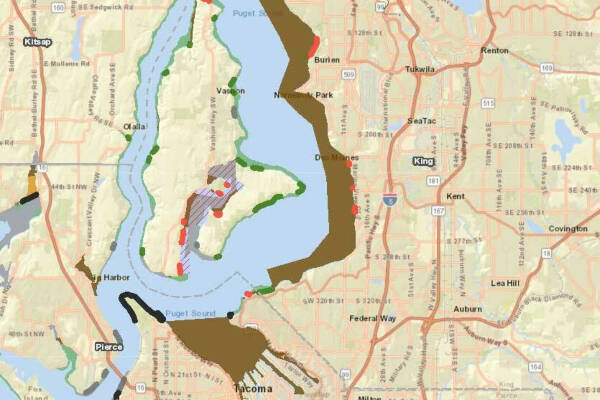The Washington State Department of Health (DOH) has awarded $5.5 million in funding to 11 proposed projects that aim to restore and protect shellfish habitats across Puget Sound, including those on Vashon and Maury islands, according to a Feb. 28 announcement.
The funding list, viewable here, outlines $455,000 in partial funding to King County — with the intent to fund in full contingent on future funds available, up to $910,000 — to target the expansion of pollution identification and correction and onsite sewage system management in Poverty Bay Shellfish Protection District and Vashon Maury Island.
These areas, according to the county, have both a high risk of fecal pollution impact on Puget Sound water quality and a high potential to maintain and upgrade harvestable shellfish beds.
Poverty Bay, located along the eastern coast of Puget Sound and extending from Federal Way to Des Moines, is an important area for both Tribal and recreational shellfish harvesting. Its geography is part of King County’s WRIA 9 watershed, which drains into the Green and Duwamish Rivers and where the rivers empty into the Puget Sound.
Primary objectives to be addressed with the funding for Poverty Bay and Vashon Maury are to:
- Expand source tracking and pollution identification to high-impact areas not yet surveyed in Massey Creek sub-Basin, in Des Moines as well as areas on Vashon-Maury Island;
- Continue freshwater monitoring in Poverty Bay … to support long-term water quality management and upgrades to harvesting areas;
- Reach new audiences — property owners on sewer and inland Vashon residents, providing financial and technical assistance for inspections and repairs; and strengthen partnerships with community-based organizations that serve disadvantaged communities;
- Improve onsite sewage system inspection enforcement and prepare for sea level rise impacts by expanding the marine recovery area to all of Vashon-Maury Island.
Beyond the Poverty Bay and Vashon-focused funding, the $5.5 million in state grants target shellfish restoration priorities in other counties: Mason, Pierce, Thurston, Skagit, Whatcom, Jefferson, Clallam, Snohomish, as well as the Swinomish and Tulalip Reservations.
According to the DOH, Washington state is the leading producer of farmed shellfish in the nation, and commercial shellfish is shipped around the world.
However, 16,000 acres of Puget Sound shellfish beds are currently closed to harvest due to nonpoint fecal pollution, such as water runoff from agricultural activities, pet waste, boater waste discharge, and onsite sewage systems.
Proposals funded by this grant will work to find and fix nonpoint source pollution.
“Washington’s marine waters are a dynamic and vital part of our unique ecosystem,” said Todd Phillips, DOH Office of Environmental Health and Safety director. “We applaud the efforts of each award recipient for their role in water quality improvement and protection. Partnerships with these awardees, along with agencies such as the EPA, emphasize the commitment and importance of advancing our goal of reducing fecal coliform pollution and protecting Puget Sound shellfish growing areas, with the overarching objective of protecting public health.”
Awardees were chosen by DOH’s Shellfish Strategic Initiative Advisory Team using Environmental Protection Agency (EPA) Puget Sound Geographic Funds. The winners each submitted requests for proposals that focused on three key investment priorities: pollution identification and correction, onsite sewage system management, and/or livestock manure management.
DOH is responsible for the safety of commercially harvested shellfish in the state. For more information on current advisories, visit the Washington Shellfish Safety Map here, which is updated daily.
Editor’s Note: This article was first published in The Auburn Reporter on March 3. It has been edited here to emphasize information about Vashon and Maury islands.



